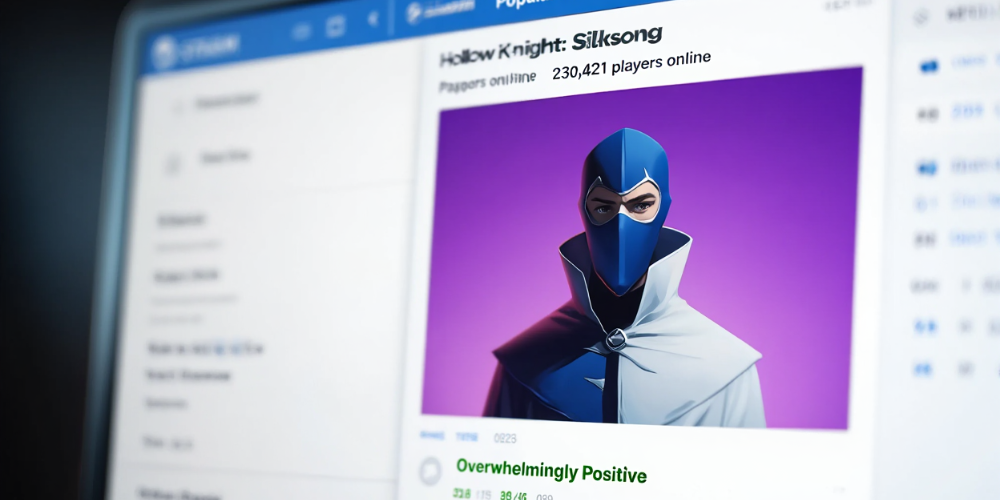How Silksong hype keeps breaking Hollow Knight’s Steam records
2025-08-25

The strangest, most delightful thing about the recent surge around Hollow Knight is how rhythmic it feels: each new flicker of Silksong anticipation, and the Steam concurrency line jumps again, then again, then again. It’s not one giant surge; it’s a drumbeat. You can feel it in the chatter on forums, in creators reopening old save files for fresh challenge runs, and in SteamDB graphs that arc upward with every tease, rating board sighting, or store page tweak. A 2017 indie metroidvania quietly holds the room, and when news around its follow-up flares, the entire audience leans forward at once. That’s not just nostalgia. It’s a live demonstration of how a strong core experience, thoughtful worldbuilding, and a fiercely engaged community can keep a game vibrant long past launch. People aren’t only replaying for comfort; they’re training, mapping routes, refining movement, and swapping tips, priming themselves for the moment a new Key clinks open somewhere in Hallownest and, hopefully soon, in Pharloom.
Main Part
What’s actually powering those repeated peaks? A stack of small forces that compound. Storefront algorithms reward momentum: when a classic starts trending, it wins a fresh spot in Discovery Queue rotations, recaptures wishlists from years ago, and surfaces on friends’ activity feeds. Add in a timely discount and you create a friendly on-ramp for curious viewers who just watched a Silksong clip, rating notice, or dev account nudge. Then the social loop kicks in—streamers reopen lore threads, speedrunners post new routes, modders refresh utility packs—and the “I’ll get to it someday” crowd suddenly installs. It’s notable that there’s been no massive mechanical overhaul to trigger this; the base game simply meets the moment. Concurrency, as tracked by public tools, crests on weekends and regional evenings, but the trendline has been decisive: repeated, short, higher highs rather than a single flash. That tells you anticipation isn’t a one-day event. It’s a sustained heartbeat that accelerates whenever Silksong inches into view.
If you’re joining the wave—new or returning—there are a few pragmatic ways to make the most of it. On PC, enable VSync to keep movement silky and cap at 60 if you prefer stability; Hollow Knight feels best when inputs land consistently. Remap dash and cast to inputs your hands reach instantly; many players like dash on a shoulder input and jump on face, but experiment until movement clicks. Early pathing that stays satisfying: Dirtmouth to Forgotten Crossroads, then Greenpath, Fungal Wastes, and into City of Tears; that route steadily expands your traversal kit without harsh spikes. Keep an eye on the Nailsmith for upgrades as soon as your ore and geo allow, and test charm synergies—Wayward Compass for orientation, Gathering Swarm for early economy, Mark of Pride or Longnail for safer spacing, and Shaman Stone if you lean into spells. Don’t worry about 100% from the start. Let the map breathe, pin benches you love, and treat late-game gauntlets like the White Palace and the Godhome pantheons as capstone goals once your movement feels natural.
There’s also a larger lesson here for how indies endure. We’ve seen long-tail revivals before—think Cyberpunk 2077’s rebound after Edgerunners, Dead Cells’ lift with its Castlevania crossover, or No Man’s Sky’s renaissance via steady updates—but Hollow Knight’s current climb is special because it’s largely community-driven without a fresh content drop. That implies durable word-of-mouth and an evergreen onboarding loop. For teams watching, the playbook looks like this: line up small but meaningful news beats; refresh your store capsule art and trailers so returning eyeballs see something crisp; time discounts alongside conversations already happening; publish patch notes with context so even minor fixes read like care; and give creators assets, press kits, and lore primers that lower the cost of making new videos. When the conversation snowballs, make it easy for fence-sitters to act now, not “sometime later.” The result can be repeated, higher peaks rather than a single spike that fades.
Conclusion
However the calendar shakes out, the message is clear: Silksong doesn’t need a launch date to move the needle—its gravitational pull is already reshaping the charts, and Hollow Knight is the immediate beneficiary. For players, that’s a gift: a perfect excuse to revisit a modern classic, catch up on endings you missed, and reattune your hands to sharp movement and patient reads. For Team Cherry, it’s a reminder that expectation, when earned, can be a renewable resource. And for anyone who cares about how great games travel across years, it’s heartening proof that a handcrafted world can hold an audience through silence, sale seasons, and tiny hints alike. Whether you’re mapping your first steps in Greenpath or lining up endgame pantheons, the present moment is lively, generous, and welcoming. When Pharloom finally opens its gates, we may see an even larger crest—but the quiet, steady climb we’re witnessing now is its own kind of triumph.






